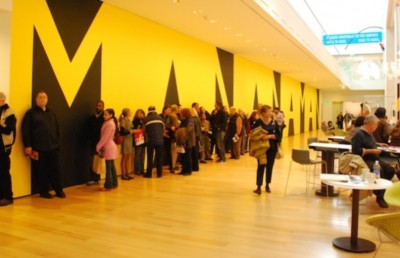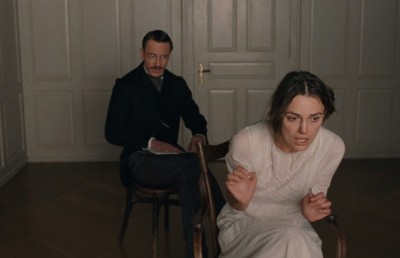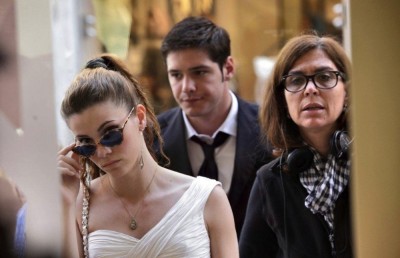American movies in Cannes 2012
The Last Great National Cinema
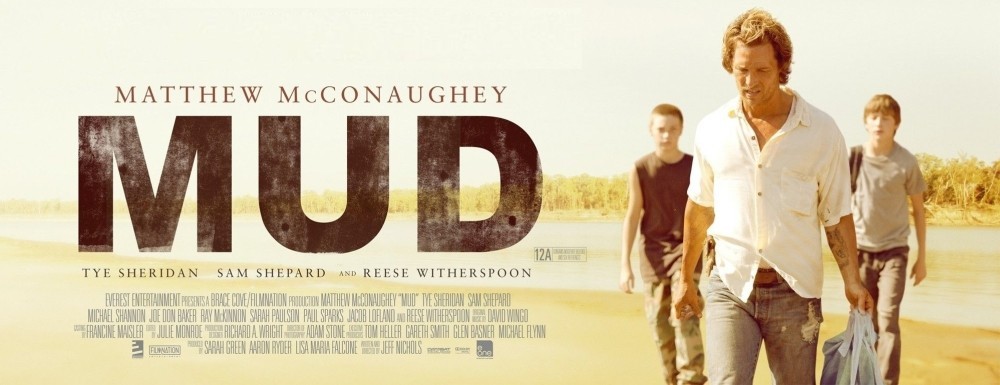
In Cannes 2012 there was a record number of American films (seven) in official competition, but none won a prize. They were all in the grand tradition of classical narration. On a thematic point of view, a look at five of these films offered a coherent and dynamic view of American cinema as national cinema. And of what might be considered “the American Way of Life.” These five movies are: Mud, Moonrise Kingdom, On the Road, The Paperboy, Lawless. I will consider another film in the “Un certain regard” section, Beasts of the Southern Wild. These six movies could be defined as “independent commercial,” a new trend and the type of movie that often needs the help of film festival to get a boost. Luckily Cannes prides itself as being the most ‘auteur’ of film festivals.
A little flashback
In the early seventies, the “Young National Cinemas” gave me great pleasure both as a film buff (cinéphile) and as a young film teacher, with the films leading to great in-class discussions with my students. These young national cinemas followed in the footsteps of the French New Wave, with political overtones and a steady defiance of the Hollywood way of seeing the world. A country had their own way of presenting themselves to the world, with a ‘personal’ filmic language.
Movies were coming out of the Soviet Socialist republics, like in the former Czechoslovakia (Milos Forman, Jirí Menzel); Poland (Andrzej Wajda, Jerzy Skolimowski); and Hungary (Iván Szabó, István Gaál, Miklos Jançso). Each cinematography was different from the other: the Italian comedy (Dino Risi, Mario Monicelli, Ettore Scola) was different from the German films which were engaged with their own history and injustices (Werner Fassbinder, Volkor Schlöndorff, Margarethe von Trotta), which was very different from the English “Free Cinema” (Lindsay Anderson, Tony Richardson, Karel Reisz), and from the cinema of Switzerland (Alain Tanner). Other emerging cinemas outside of Europe also led to great discoveries, like Brazil (Glauber Rocha) and Cuba (Tomás Alea, Humberto Solas); Québec was also a part of that discovery (Claude Jutra, Gilles Groulx). The seventies was, in fact, a period of political cinema, with new imagery and a new imaginary. The influence of the direct cinema, of historical reconstitution and of a very clear factual form was very important. In the eighties it became clear that the new Hollywood blockbuster had made huge gains on screens across the world, leaving the National Cinemas with little space; but this ‘National’ movement would make a big comeback in the nineties.
During 1990-2010 there was a comeback and discovery of new countries and cinematographical forms, a rebirth of national cinemas. First with the Iranian cinema <Mohsen Makhmalbaf, Jafar Panahi, Majid Majidi>, the Romanian wave <Lucian Pintilie to Cristian Mungiu>, the cinema of Belgium: French <Frères Dardenne> and Flemish <Geoffrey Enthoven, Christophe Van Rompaey>; true of Israël <Amos Gitai, Eran Kiklis, Ari Folman>. South America would send us new directors and great movies <Carlos Reygadas and Alejandro González Iñárritu from Mexico>; Salles from Brazil <here for the United States>; Pablo Trapero from Argentina. But the most important contingent of countries to give us a collective impression of a National Cinema came from Asia.
After the famous “Fifth Generation” of China (Chen Kaige, Zhang Yimou) came many others from different countries across Asia. Especially from Taïwan (Edward Yang, Hou Hsiao-hsien), South Korea (Kim Ki-duk, Park Chan-wook), and Japan (Kiyoshi Kurosawa, Takashi Miike). The continent of Asia provided a host of filmmakers that rejuvenated the notion of a National Cinema. And Cannes looked across the scope of these exotic national cinemas, highlighting Kiarostami, Jia Zhang-ke, Amos Gitai, Inàrritu, Apichatpong Weerasethakul, etc. But aside from these few great directors, who express themselves with a personal voice, there is still the dominance of the strictly commercial movie. This trend is not aided by the continuing loss of movie houses dedicated to repertoire cinema. So, I found it quite fascinating to see a trend at this year’s Cannes film festival of independent American ‘national’ cinema trying to escape the Hollywood dictatorship of mere entertainment.
American films in Cannes 2012Mud (Jeff Nichols, 2012) and Moonrise Kingdom (Wes Anderson, 2012)

We will begin by comparing these two movies which both feature an island as a central figure and a space for dramatization; the island being a vast metaphor for the United States. When you are living on an island it is all too easy to imagine the world outside as being secondary, if not irrelevant, to this little magical world that you can call “your own.” The average American, and their politicians in particular, are the same: incapable of a getting a good handle on geo-politics, of the world outside the “island.” On the other hand, an island is a wonderful place for dreams, for Utopia. America is the land of dreams, the land of the “pursuit of happiness.” When these dreams are personalized through the eyes of teenagers you can think you are back to The Adventures of Huckleberry Finn. In both movies the island is a refuge for teens: for the two boys in the Nichols’s movie, and for a boy and a girl in Moonrise Kingdom. The island is then a place where dreams of solitude, love, wondrous if not miraculous things, are possible. The name Penzance for the island in Moonrise Kingdom is in itself a reference. Like in the Broadway musical The Pirates of Penzance; here the pirates are Suzy (Kara Hayward) and Sam (Jared Gilman) and they live in a world of wondrous images. Moonrise Kingdom is a coming-of-age love story. Love has to be beautiful, real, and, most of all, different from what they see around them (in both movies). In both movies, as in so many American movies, love has to be linked with Nature (Islands).
These two marginal teenagers of Moonrise Kingdom search for a beach where Indians would have lived in great happiness; where they could really love each other. This being said, we are far from the world of The Blue Lagoon. Love is everything and if you don’t have it you have nothing. The Françoise Hardy song (we could hear Charles Trenet in The Darjeeling Limited) over which our young couple will dance and kiss the first time is very romantic. But it takes place on the sought after beach, composed on a completely original island landscape. Moonrise Kingdom emphasizes expressionist decors, and a miniaturist view of the world suggestive of previous works by Anderson, like The Darjeeling Limited, where the colors, set decoration, and costumes blend in a form of surrealism and magic.
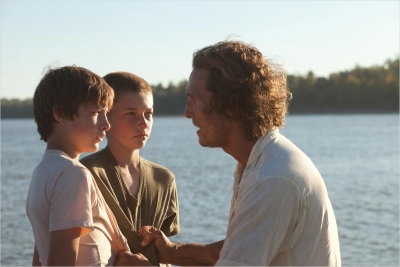
In Mud, fourteen year olds Ellis (Tye Sheridan) and his friend Neckbone (Jacob Lofland) find a suspended boat in a tree on an island on the Mississippi River. They think this will be their secret hideaway but in fact there is already someone using the boat, the titular character Mud (played very forcefully by Matthew McConaughey). Mud reminds us of a sort of Satan: under his shoes a special marker made of nails imprints crosses on the sand and he has a tattoo of a snake on his arm. Mud is the King Kong of the island. The two teens want to relive the grand old pioneer spirit, or something close to Davy Crockett. And, here again, we have a “coming of age” narrative structure. In Mud the teens confront an image of American masculinity that can change their life. That Mud is embedded in the ‘tough guy’ American mythology helps nourish the “coming of age” dimension of the story; making it even more a slice of Americana. Mud is filmed in a classical form, which reflects its return to the roots of American values.
Lawless (John Hillcoat, 2012)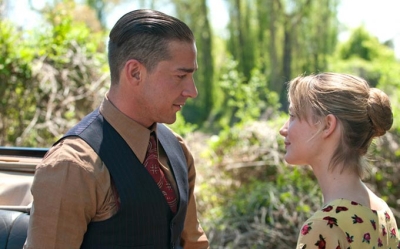
To create an American national cinema it is a good idea to go back to a genre that helped shape the American psyche: the gangster movie does that (as well as the western). The film’s publicity states: “Brazen and fearless, these young rebel brothers helped build the American Dream.” John Hillcoat, with the help of that genre, aim to achieve that ‘dream’.
Lawless is a gangster movie set during the prohibition-era of the thirties. It is also, in part, a western. The end of the prohibition era looks like the end of the western era in this movie. The Bondurant brothers, Forrest (Tom Hardy), Howard (Jason Clarke) and Jack (Shia LaBeouf), have developed a thriving, small-scale moonshine business. Their operation is threatened with the arrival of Special Deputy Charlie Rakes (Guy Pearce), who brings with him a new breed of the “law,” one that is lethal and corrupt, challenging everything the brothers have built. While the rest of the county gives in to Rakes, the Bondurants will bow to no one, even if it means putting everything on the line, including their relationship with each other.
The Australian director Hillcoat sees in the prohibition era (in this sense Lawless is also an historical movie) a chance to challenge some of the great founding myths of America, like the idea of a nearly invincible super-hero (which is what everybody says about the Bondurants : they seem to be immortal). As a new young director from outside the United States he accords a certain level of respect to the Hollywood classical cinema, while shaking off some of the obsessions of the American psyche. The film offers a good story, with enough stars (Shia LaBeouf, Gary Oldman, Jessica Chastain) and violence to ensure commercial success. It is a good para-Hollywood product. The outstanding images of cinematographer Benoît Delhomme (giving real colors to the Virginia landscape), and the great respect for the original language of the people, renders a form of realism that is more typical of the independent movies coming out of the United States. This is combined with the great musical work of Nick Cave (also the co-writer, like he was for two other Hillcoat films). Music and image work together to build a classical way of bridging together action scenes and some more romantic scenes. The story is based on the book The Wettest County in the World by Matt Bondurant (a fictionalized account of his own family) and thus gives even more accuracy and a feeling of truth and life to the story.
Beasts of the Southern Wild (Benh Zeitlin, 2012)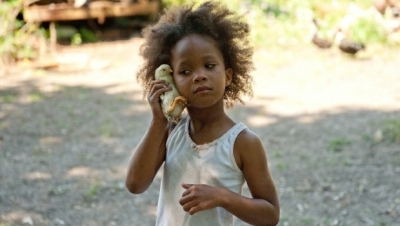
Beasts of the Southern Wild won the “Camera d’Or,” the “Regard Jeune,” prize, but also, and very rare, both the Fipresci Prize (by critics of around the world) and the 2012 Ecumenical Prize. Before that it had won a Grand Jury Prize at the Sundance Festival. It is quite a start for a first movie for Benh Zentlin. Zentlin was born a New Yorker but he now lives in Louisiana. The story takes place in Louisiana, a South where the poor blacks and poor white can finally come together, another aspect of the American dream.
Hushpuppy (Quvenzhané Wallis), a six-year-old girl, lives with her father, Wink (Dwight Henry), in the “Bathtub.” Bathtub is the name given to the Bayous of Louisiana because of the dams build to avoid another hurricane Katrina. These poor folks now live in sort of caged world. As the island in Moonrise Kingdom and Mud, this mythical “Bathtub” can also be seen as a metaphoric image of America. An America threaten by the “floods” of new waves and new beasts. When another storm hits they have to survive and they have to help each other. But, the real goal of Hushpuppy is to find her mother, especially when Wink becomes ill. Then to make matter more difficult an army of prehistoric creatures (called aurochs) emerge to reclaim the planet (so says the teacher). Beasts of the Southern Wild is an ode to survival, to marginality, to hope, to Life. Bringing together some of the more profound themes of the American cinema, like the Henry Thoreau-inspired communion with nature. The myth of the return of old-fashioned animals is clearly a reflection on the very real dangers of global warming. In spite of an impoverished budget Zeitlin succeeds in creating poetical rich visual compositions. The movie’s stage origins (based on the play Juicy and Delicious by co-scenarist Lucy Alibar) do not really show, except perhaps for the sometimes redundant use the lead character’s (Hushpuppy) voice-over.
This movie has tremendous cinematographic qualities but what will surely touch every spectator is the character and performance of Hushpuppy (played by Quvenzhane Wallis). Not forgetting also that a child is often the best spokesperson for the future of America. The movie, and Hushpuppy, “speaks fluently and truly for the place, people and culture it so indelibly depicts” (Hollywood Reporter).
The Paperboy (Lee Daniels, 2012)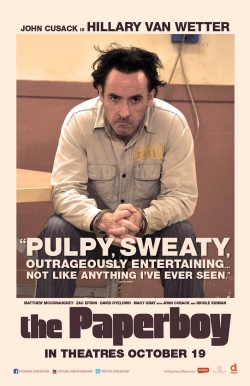
Very different from his previous movie Precious, Lee Daniels resorts to a no-holds-barred seventies genre movie. Again we find an independent film with a strong commercial streak: stars (again Matthew McConaughey, Nicole Kidman, Zac Efron, John Cusack) with a dark, but entertaining story. However, the film was very badly received in Cannes.
Jack Jensen (Zac Efron) is the son of a newspaper tycoon, living in rural Florida in the summer of 1969. His older brother Ward (Matthew McConaughey) returns home, with black journalist writer Yardley Acheman (David Oyelowo), at the behest of the town “tramp” Charlotte Bless (Nicole Kidman) to investigate the alleged crime of a death-row inmate that she’s fallen in love with, Hilary Van Wetter (John Cusack).
Similar to Lawless in a way, this is ostensibly a tale of murder. A thriller “that studies sex and race and the coming of age of a boy to manhood” (Lee Daniels). The “coming of age” (recalling both Mud and Moonrise Kingdom) applies here to the character of Jack Jensen (Zac Efron), who is highly excited by the sexualized Nicole Kidman character. Since the plot fades to the background (all shot in Louisiana, the home of Beasts of the Southern Wild), The Paperboy has its own style : it follows the whims of its storyteller, sometimes emphasizing racism, elsewhere exploring sexual tensions, and finally melting into a contrived thriller in its closing moments. In fact it is a hybrid movie, something which worked against it as evidenced by the negative reception from the critics at Cannes. But the tradition of the best American auteur cinema has very often been hybrid (beginning with the classic Citizen Kane). The mainstream critics in Cannes clearly did not appreciate Daniels’ film; it was too blunt in its excesses for this public. Perhaps with this in mind, Daniels stated very clearly that he wanted to feature a black man and homosexual in his film, so that, for instance, the character of Yardley (who is black and homosexual) had to live a double life to get his position as a Miami Times reporter.
On the Road (Walter Salles, 2012)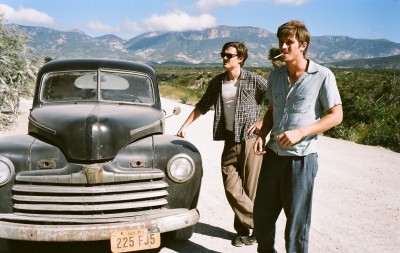
A movie about Jack Kerouac has to be a movie about the American Dream. But not exactly what we usually understand as the American Way of Life. Here we get a rendition of the American Dream from a director, Walter Salles, not born in the USA but hailing from one of the aforementioned National Cinemas (like Milos Forman did before him). These directors normally have a more critical approach to the American Dream. Like Salles the principal character, Jack Kerouac, was not American, but French-Canadian (Franco-American). Jack Kerouac was a sort of last “lonesome cowboy” who embodied the end of the American dream of the great Western conquest.
The day after his father dies Sal Paradise (the name chosen by Jack Kerouac for his lead character in his novel On the Road) decides to search for a new meaning in his life. He goes on the road with his friend Dean Moriaty (Garrett Hedlund) and their girlfriend Marylou (Kristen Stewart). But in fact Paradise has only one big dream: to write. This part is quite well rendered in the movie. We often see Paradise/Kerouac writing, everywhere, on everything. But outside his writings his world seems reduced to drugs and sex.
Salles uses, as he did with The Motorcycle Diaries, the road-movie prototype. What was good for Che Guevara is even better for Jack Kerouac. And what better than a road-movie to help us discover the American landscape. But, the truth is that we see more of the “beat generation” sleeping with each other than we see of the American landscape. The great lesson of Easy Rider (1969) is lost. What remains with On The Road is the idea that the American Dream is the best dream that can exist, even with its errors or obstacles. The Great Utopia is still there.
Sal Paradise travels from North (Lowell, Massachusetts, his birthplace) to South (California, land of Hollywood). Hollywood is the place where America was reborn, through the works of directors such as Griffith, Chaplin, and Capra. The six movies I’ve focused on represent different aspects of “Americana,” situated in the South were the real America still seems to exist. Very often Louisiana is the reference point (we could go back to an old classic B movie The Lure of the Swamp, 1957 by Hubert Cornfield, to have a title that says it all). Foremost is that these “new” American movies in fact relay the classical cinema of identification and strong audience participation, qualities sometimes lacking in the other new National cinemas.



